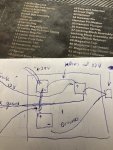Ronmar
Well-known member
- 4,458
- 8,370
- 113
- Location
- Port angeles wa
Tap into the line between the panel and the house controller. You want raw DC to feed the small controller to the 3rd battery the same as it feeds the house system. Dc to dc converters work best when there is a voltage difference so you dont want to use the output of the house converter which is basically the same voltage as you want to feed the 3rd…Now im already using a controller from solar to house batteries so go in behind my other controller and ad this dc/dc thing or just run a piece of #10 from my controller to the 3rd 6tl instead of the 2/0 i have down there now ! or your saying tap in the line coming from panels before it gets to solar controller then onto the 3rd 6tl
the whole point of the added dc-dc controller is to NOT add a different sized battery to the house bank which will effect the way BOTH charge(and not in a good way)…
You can temporarily tie the 3rd into either the house bank or the service system to use that energy in those systems, but for longest life you want the 3 different sized systems to charge independently of each other on their own controllers…



